Worryingly, this may be the limit of some students' knowledge about genes (Credit: http://www.offthemark.com/cartoons/genetics)
I consider myself very lucky that I get to work with
academics at the cutting edge of science research, as well as with high school
students and teachers.
While I get to peer into both the world of university and
the world of high school, I appreciate the huge chasm that exists between these
two worlds and the lack of communication between them. Academics who teach
university students don’t really know what their students have studied in their
subjects at high school, and conversely, school teachers don’t know what will
be expected of their students at uni. This is a serious problem, considering
that more than 50% of high school graduates proceed to study at university.
It’s becoming increasingly obvious that the current syllabuses
for science are worryingly outdated compared with our current knowledge and
research focuses. As schools get ready to introduce a new Australian curriculum
over the next few years, it will be interesting to see how much “new” genetics
students will be required to learn.
It is understandable that high school science syllabuses can’t
keep up with all new discoveries as they happen. It takes time to develop a new
syllabus, and even more time for teachers to become familiar enough with a
syllabus to be able to teach it confidently.
Nevertheless, for genetics and molecular biology in
particular, there is a shamefully long lag time between the publication of
discoveries in scientific articles and when they finally feature in school text
books.
High school genetics is, unfortunately, stuck in a strange
time warp. Techniques, such as the polymerase chain reaction (PCR), don’t even
rate a mention in today’s HSC Biology syllabus, despite revolutionising the
field of genetics when it was developed in 1983.
The absence of any reference to PCR in the HSC Biology syllabus means that Year 12s will sadly never appreciate lame genetics cartoons like this one (Credit: http://www.yalescientific.org/tag/cartoon/)
The limit of many students’ understanding by the end of Year
12 is that blue eye colour is determined by whether you have one or two copies
of the recessive allele. Most students have no appreciation that characteristics
encoded by a single gene locus are the exception rather than the rule, and some
characteristics can be encoded by hundreds of different gene loci.
While students learn about the Darwin’s theory of evolution,
they are totally unaware of recent major paradigm shifts in genetics, such as
the emergence of epigenetics in the early 2000s. Epigenetics is the study of the
dynamic system that encodes gene expression in a cell, and provides a mechanism
to explain how environmental effects on phenotype can be inherited from
generation to generation. I dare say that even most high school teachers, let
alone their students, are unaware that Lamarck’s theories have enjoyed this new
lease on life.
More advanced concepts, such as the Human Genome Project and
gene cloning, are covered in the genetics option module in the HSC Biology
syllabus. However, few schools select to teach this option to their students,
because it is more difficult than the other option modules.
I can appreciate that genetics is a difficult subject to
study for many students, and sometimes a difficult subject to teach. However, I
don’t think the solution is to teach content that is so simplified and watered
down that it is almost irrelevant and incorrect. The result is students who
really struggle to study any sort of genetics or molecular biology in first
year university.
I really hope to see a properly updated genetics section of
the Australian Biology curriculum when the final draft is released. It may also
require some significant professional development for teachers to update them
on our current understanding of genetics. Finally, it will be crucial to update
the new syllabus every year or two to incorporate new examples of current
research, to ensure we don’t end up with the problem of a syllabus that is up
to 20 years out of date in 20 years time.























